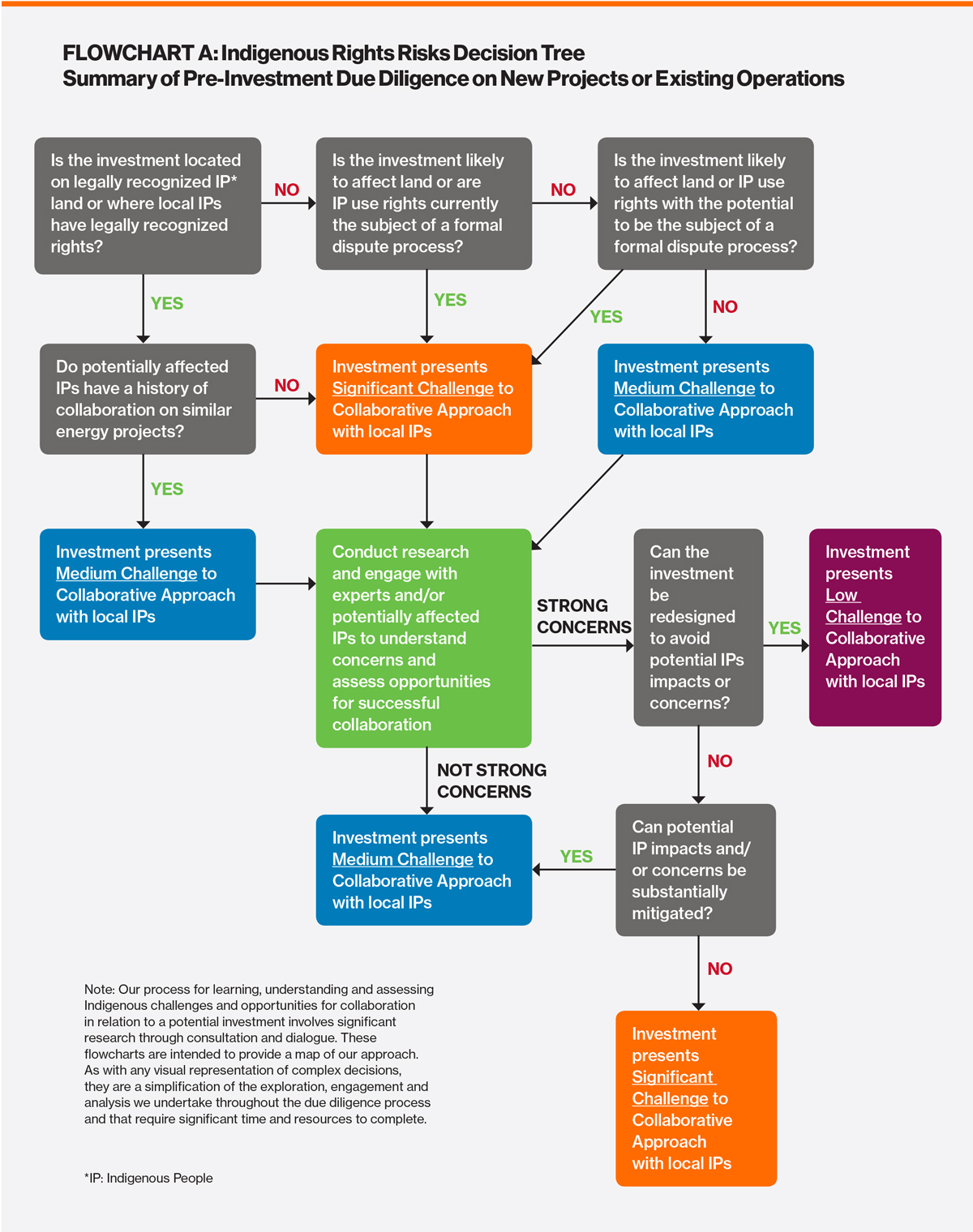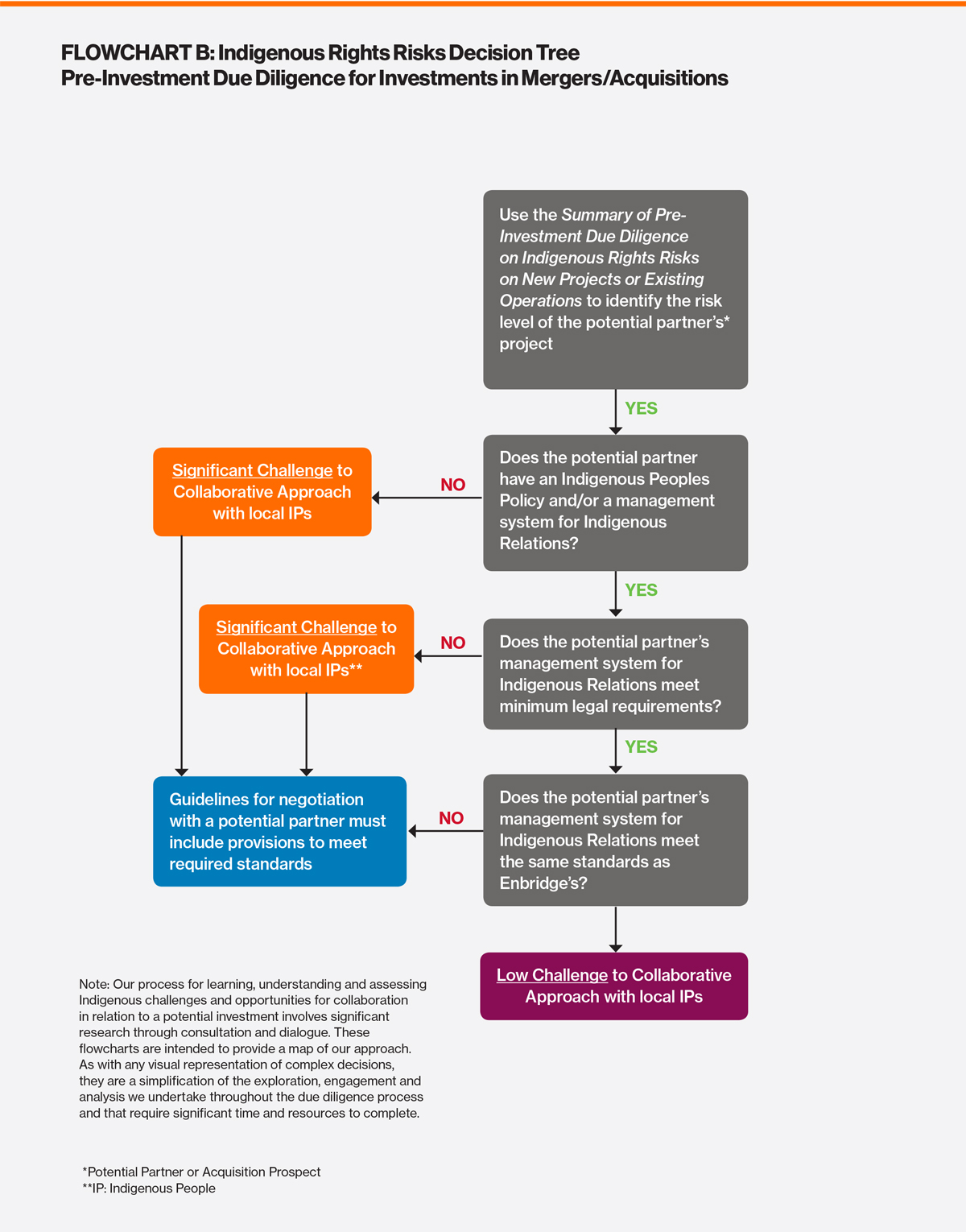Integrating Our Indigenous Peoples Policy in Key Management Systems: A Focus on Investment Review
Indigenous Due Diligence in Investment Review
As part of our investment review process, Enbridge formally evaluates risks related to environmental, social and governance matters. In a situation that would potentially involve the interests of Indigenous Nations and groups, this would include an analysis of the land in question, known Indigenous sites or interests in that land, other limitations on that land, a review of historical uses and potential challenges to other projects in that area, and an analysis of the Indigenous communities and their claim to the areas. Additionally, the assessment would also consider the broader context that exists in that jurisdiction at the time of the proposed investment, including the current regulatory, political and social contexts. If the investment opportunity involves a potential partner, the partner’s policy, actions and history on Indigenous issues would also be relevant. Finally, the assessment would comment on the ability of our management systems, practices and other processes (e.g. voluntary agreements, regulatory review) to mitigate potential risks. Outcomes from our investment review processes are used to advise our Investment Review Committee of risk levels and recommended mitigation options, and are incorporated into final recommendations made to the Enbridge Board of Directors.
In 2017 our Investment Review group undertook a Best Practices in Capital Allocation initiative, which updated our processes for assessing, evaluating and mitigating risks in investment review processes at Enbridge. The updated processes apply to all proposed Enbridge investments, including investments in new projects and ongoing operations as well as minority or majority investments in joint ventures or partnerships. In relation to risks to and from Indigenous rights (“Indigenous rights risks”), the following definitions, questions and considerations have been added to our due diligence processes (see process summary in Flowcharts).
Note: Risks to and from Indigenous rights (“Indigenous rights risks”) arise from proposed Enbridge investments in projects, assets or operations either in, or in proximity to, areas subject to the assertion of Indigenous rights to land, air and water. Consistent with Enbridge’s Indigenous Peoples Policy, an assessment of Indigenous rights risks must be conducted as an element in pre-investment due diligence. The assessment must be based on an analysis of the potential for collaboration with local Indigenous communities on shared social, economic and environmental concerns and opportunities.
Definition: Low Challenge to Collaborative Approach with Local Indigenous Peoples (“IP”)
The concerns of local Indigenous Peoples are likely to be addressed through the application of management systems and/or sufficient project flexibility.
Definition: Medium Challenge to Collaborative Approach with Local Indigenous Peoples
The proposed investment will, or is likely to be perceived to, affect local Indigenous Peoples and it is likely that legal, reputational and operational risk can be managed through a proactive approach of consultation, mitigation and mutual benefits. Some indicators of the likelihood that these risks can be managed include, among others, a history of the affected community participating in energy projects when they believe they are treated respectfully, potential adverse impacts are effectively mitigated, and they benefit from the project.
Due to changing views and expectations among some Indigenous Nations and groups some communities that previously participated in energy infrastructure projects may no longer do so, or may demand additional safeguards from project proponents. Due to this potential unpredictability, proposed investments with these attributes are not classified as low risk.
Definition: Significant Challenge to Collaborative Approach with Local Indigenous Peoples
The proposed investment will, or is likely to be perceived to, affect local Indigenous Peoples and it is uncertain whether legal, reputational, and operational risk can be managed—even through robust company efforts and regulatory compliance. The company will therefore need to devote significant resources to engaging with the affected Indigenous Nations and groups. To address concerns, it may be necessary to create enhanced opportunities for joint environmental and social monitoring initiatives, help affected groups obtain independent expertise, and provide mutual benefits. In some instances, this may be sufficient to address Indigenous concerns. Some groups may, however, still be opposed to energy infrastructure development, or may believe that the advancement of the proposed project or operations in question will affect their interests or otherwise compromise their legal claims to traditional cultural rights and/or positions they are currently taking on related matters with federal, state/provincial, or local governments.

FLOWCHART A: Indigenous Rights Risks Decision Tree
Summary of Pre-Investment Due Diligence on New Projects or Existing Operations







